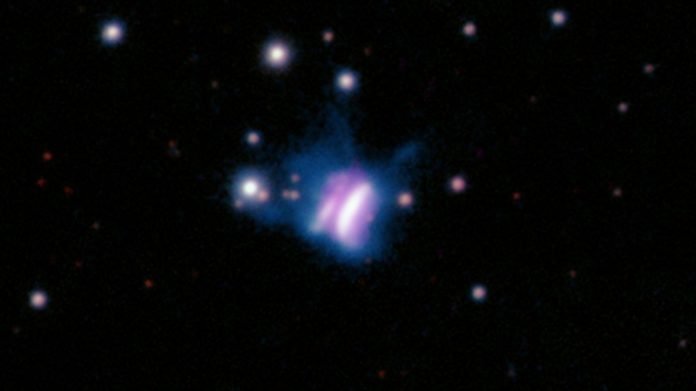
Astronomers have made an exciting discovery: a gigantic, cosmic butterfly in the night sky that turns out to be the largest planet-forming disk ever seen.
Known officially as IRAS 23077+6707 (IRAS 23077 for short), this amazing sight is about 1000 light-years away from Earth.
It was first spotted in 2016 by Ciprian T. Berghea from the US Naval Observatory using the Panoramic Survey Telescope and Rapid Response System (Pan-STARRS), but its true nature remained a mystery until now.
Two new studies have uncovered the secrets of IRAS 23077. One paper, led by Berghea and accepted for publication in The Astrophysical Journal Letters, revealed that IRAS 23077 is a young star surrounded by a massive planet-forming disk.
The second paper, published in The Astrophysical Journal Letters, confirmed this discovery using data from the Submillimeter Array (SMA), an array of telescopes in Hawaii.
The SMA, operated by the Smithsonian Astrophysical Observatory (SAO) and the Academia Sinica Institute of Astronomy and Astrophysics (ASIAA) in Taiwan, detects light at millimeter wavelengths.
This type of light, a form of radio waves, helped scientists understand the physical nature of IRAS 23077.
Kristina Monsch, an astrophysicist at SAO and a postdoctoral fellow at the Center for Astrophysics | Harvard & Smithsonian (CfA), led the SMA observations. “What we found was incredible – evidence that this was the largest planet-forming disk ever discovered,” said Monsch.
“It is extremely rich in dust and gas, which are the building blocks of planets.”
Planet-forming disks, or “protoplanetary disks,” are where planets like Earth and Jupiter form around young stars. These disks are rich in dust and gas and rotate in a way that astronomers can use to measure their size and the mass of their central stars.
Some disks, like IRAS 23077, are oriented edge-on, meaning they can obscure their parent star’s light, but their dust and gas can still be seen with millimeter-wavelength telescopes like the SMA.
“The SMA data offers smoking-gun evidence that this is a disk,” said Monsch. “It is rotating around a star likely two to four times more massive than our Sun and has enough material to form many giant planets, reaching over 300 times further out than the distance between the Sun and Jupiter.”
This discovery raises important questions. “How many more of these objects have we missed?” asked Joshua Bennett Lovell, a co-author and SAO astrophysicist. Further study of IRAS 23077 and similar objects could unlock the secrets of how planetary systems develop in their early years.
IRAS 23077 was playfully nicknamed “Dracula’s Chivito” by Berghea, drawing inspiration from his Romanian heritage and a suggestion by his co-author, Ana Mosquera, to name it after Uruguay’s national dish, the “chivito.”
This fascinating discovery involved a team of researchers including Kristina Monsch, Joshua Lovell, Jeremy Drake, Ciprian Berghea, and others from institutions like the Max Planck Institute for Astrophysics, CfA, and the University of Hawaii.
Source: KSR.



